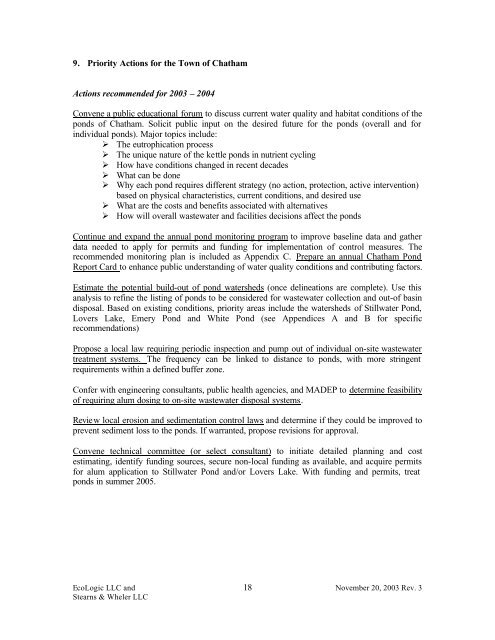Action Plan for the Town of Chatham Ponds
rev 3a report.pdf - Town to Chatham
rev 3a report.pdf - Town to Chatham
Create successful ePaper yourself
Turn your PDF publications into a flip-book with our unique Google optimized e-Paper software.
9. Priority <strong>Action</strong>s <strong>for</strong> <strong>the</strong> <strong>Town</strong> <strong>of</strong> <strong>Chatham</strong><br />
<strong>Action</strong>s recommended <strong>for</strong> 2003 – 2004<br />
Convene a public educational <strong>for</strong>um to discuss current water quality and habitat conditions <strong>of</strong> <strong>the</strong><br />
ponds <strong>of</strong> <strong>Chatham</strong>. Solicit public input on <strong>the</strong> desired future <strong>for</strong> <strong>the</strong> ponds (overall and <strong>for</strong><br />
individual ponds). Major topics include:<br />
‣ The eutrophication process<br />
‣ The unique nature <strong>of</strong> <strong>the</strong> kettle ponds in nutrient cycling<br />
‣ How have conditions changed in recent decades<br />
‣ What can be done<br />
‣ Why each pond requires different strategy (no action, protection, active intervention)<br />
based on physical characteristics, current conditions, and desired use<br />
‣ What are <strong>the</strong> costs and benefits associated with alternatives<br />
‣ How will overall wastewater and facilities decisions affect <strong>the</strong> ponds<br />
Continue and expand <strong>the</strong> annual pond monitoring program to improve baseline data and ga<strong>the</strong>r<br />
data needed to apply <strong>for</strong> permits and funding <strong>for</strong> implementation <strong>of</strong> control measures. The<br />
recommended monitoring plan is included as Appendix C. Prepare an annual <strong>Chatham</strong> Pond<br />
Report Card to enhance public understanding <strong>of</strong> water quality conditions and contributing factors.<br />
Estimate <strong>the</strong> potential build-out <strong>of</strong> pond watersheds (once delineations are complete). Use this<br />
analysis to refine <strong>the</strong> listing <strong>of</strong> ponds to be considered <strong>for</strong> wastewater collection and out-<strong>of</strong> basin<br />
disposal. Based on existing conditions, priority areas include <strong>the</strong> watersheds <strong>of</strong> Stillwater Pond,<br />
Lovers Lake, Emery Pond and White Pond (see Appendices A and B <strong>for</strong> specific<br />
recommendations)<br />
Propose a local law requiring periodic inspection and pump out <strong>of</strong> individual on-site wastewater<br />
treatment systems. The frequency can be linked to distance to ponds, with more stringent<br />
requirements within a defined buffer zone.<br />
Confer with engineering consultants, public health agencies, and MADEP to determine feasibility<br />
<strong>of</strong> requiring alum dosing to on-site wastewater disposal systems.<br />
Review local erosion and sedimentation control laws and determine if <strong>the</strong>y could be improved to<br />
prevent sediment loss to <strong>the</strong> ponds. If warranted, propose revisions <strong>for</strong> approval.<br />
Convene technical committee (or select consultant) to initiate detailed planning and cost<br />
estimating, identify funding sources, secure non-local funding as available, and acquire permits<br />
<strong>for</strong> alum application to Stillwater Pond and/or Lovers Lake. With funding and permits, treat<br />
ponds in summer 2005.<br />
EcoLogic LLC and 18<br />
November 20, 2003 Rev. 3<br />
Stearns & Wheler LLC
















